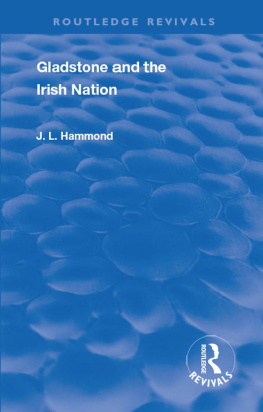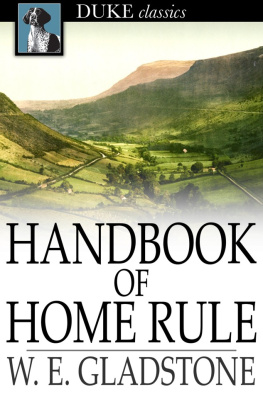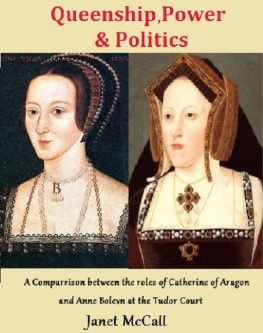
Catherine Glynne was born in 1812, in the same year as Charles Dickens. An earls daughter she married the son of a self-made merchant, William Ewart Gladstone, who became Queen Victorias Prime Minister on four occasions. While the Queen and the PM loathed each other, they both loved Catherine, Gladstones wife. After a long and indecisive courtship, Gladstone said of his new wife that my Cathie forever twinkles. Society remarked that her beauty showed a profound intelligence. Catherine loved being in the main stream of action but disliked politicians, fashion and social niceties. Unusual for the time Gladstone was present at the birth of each of their eight children and Catherine insisted on feeding them herself.
Mrs Gladstones primary concern was support of the poor in particular those suffering from cholera, near-starving mill girls and homeless orphans. She established the concept of free convalescent homes and her common-sense influenced the Poor Laws. To maintain her genius for charity she took every opportunity to approach Gladstones friends for financial support for her good works. In return she found places for her husbands rescue women young girls forced into prostitution as a result of poverty. When her brothers ironworks failed Catherine and her family faced poverty. It was Gladstones financial skills that saved the family from bankruptcy. Catherine died on 14th June, 1900.
Pertinent to this biography is the letter the author wrote to the Church Times about the reasons behind the riots in London and elsewhere in the United Kingdom, in August 2011. The letter header Mrs Gladstone! thou shouldst be living at this hour drew attention to a personality who in her time confronted severe social need through community action.
Cover illustration: Watercolour of Catherine Gladstone, circa 1849, courtesy of Charles Gladstone.
Janet Hilderley is the author of Mr Disraelis Rattle, the love story of Benjamin Disraeli and Mary Wyndham Lewis as they traversed the politics and social scene of Victorian Britain.
She was unquestionably a remarkable woman, and very few persons have spent a more unselfish life than she did, in actually striving to do good to others in the kindest possible way. Her first consideration was her husband how to spare him and how to advise him to spare himself. Her second consideration was the poor and the sick; and her third consideration her friends.
(Sir Edward Hamilton (18471908) paid this tribute to Mrs. Gladstone at the time of her death. He was private secretary to Mr. Gladstone from 1880 to 1885 and retained links with the family even after being appointed as Permanent Secretary to the Treasury in 18851907. Under the pseudonym Nemo, Sir Edward published a diary of political gossip. Sir Edward died in 1908, unmarried.
Copyright Janet Hilderely, 2013, 2014.
Published in the Alpha Press e-Library, 2014.
First published 2013 in Great Britain in the United Kingdom by
THE ALPHA PRESS
PO Box 139 Eastbourne BN24 9BP
and simultaneously in the United States of America and Canada
All rights reserved. Except for the quotation of short passages for the purposes of criticism and review, no part of this publication may be reproduced, stored in a retrieval system, or transmitted, in any form or by any means, electronic, mechanical, photocopying, recording or otherwise, without the prior permission of the publisher.
British Library Cataloguing in Publication Data
A CIP catalogue record for this book is available from the British Library.
Library of Congress Cataloguing-in-Publication Data
Hilderley, Janet.
Mrs. Catherine Gladstone : a woman not quite of her time/ Janet Hilderley.
p. cm.
Includes bibliographical references and index.
ISBN 978-1-898595-55-7 (pbk. : acid-free paper)
ISBN 978-1-898595-56-4 (e-pub)
ISBN 978-1-898595-57-1 (e-mobi)
ISBN 978-1-898595-58-8 (e-pdf)
1. Gladstone, Catherine Glynne, 18121900. 2. Gladstone, W. E. (William Ewart), 18091898. 3. Great BritainHistoryVictoria, 18371901. 4. Prime ministers spousesGreat BritainBiography. 5. Great BritainPolitics and government18371901. I. Title.
DA563.9.H55 2013
941.081092dc23
[B]
2012029461
This e-book text has been prepared for electronic viewing. Some features, including tables and figures, might not display as in the print version, due to electronic conversion limitations and/or copyright strictures.
Contents
CHAPTER ONE
A Meeting, a Marriage and Rising Power To 1840
CHAPTER TWO
Death of a Daughter, Ladies of the Night and Financial Disaster The 1840s
CHAPTER THREE
Journey to Naples, King of an Island and Good-bye to a Sister The 1850s
CHAPTER FOUR
Upsetting Miss Nightingale and Fighting for Poor Suffering Humanity Victorian Poverty
CHAPTER FIVE
A Loving Wife, a Widowed Queen and Preparing for Power The 1860s
CHAPTER SIX
Enter Disraeli, Departing Brothers and A Great Political Campaign The 1870s
CHAPTER SEVEN
A Time of Change, the Great Courtesans and Murder The1880s
CHAPTER EIGHT
Death of a Soldier, Ireland, a Jubilee and Mrs. Gladstone Enters Politics 18861892
CHAPTER NINE
Winds of Change and Departure 18921896
CHAPTER TEN
Good-bye Catherine 18971900
Preface
Working in the voluntary sector, often in old established charities, I came across the name of Mrs. Gladstone. I was intrigued. This was a woman who moved in the highest circles. She was married to one of the most interesting men of the age, produced eight children and yet managed to be a leading figure in the world of Victorian charity.
Catherine came alive for me when I began to read books written by those who knew her Lord Morleys biography of Gladstone (1903); Mary Drews life of her mother (1920); and Edwin A. Pratts, Catherine Gladstone: Life, Good Works and Political Efforts (1898), which dealt mainly with her charitable activities. Comparing her experience with my own in the voluntary sector made me realize how much Catherine Gladstone influenced the social and political world around her.
Material taken from diaries and letters have been italicized in the text; quote marks are used to indicate direct quoted speech from these sources, and emphasize the vividness of the occasion or circumstance, such as at the end of Mary could be heard calling out, Lavinia, we are going to Dizzys party next Wednesday. Oh! It will be such fun!
My thanks go to Mr. Charles Gladstone for the use of the portrait of Mrs. Gladstone on the front cover of the book, to Peter Francis, the Warden of Gladstones Library, for answering endless questions and to the Reference Librarians of Guildford Public Library who obtained books for me from the British Library. My personal thanks go to Anne Bowerman for advice and support and to Steve Mitchell of Radstone Computer Services, who brought my script on Mrs. Gladstone into the IT age.
CHAPTER ONE
A Meeting, a Marriage and Rising Power
To 1840
B EGINNINGS
A non proposal
It was already midnight, this 3rd day of January 1839. A youngish man and woman stood close together, closer than politeness demanded. Friends and family tactfully disappeared, leaving the two alone, hidden in the haunting, mysterious shadows of the Coliseum in Rome. Recalling that night, Catherine wrote,







